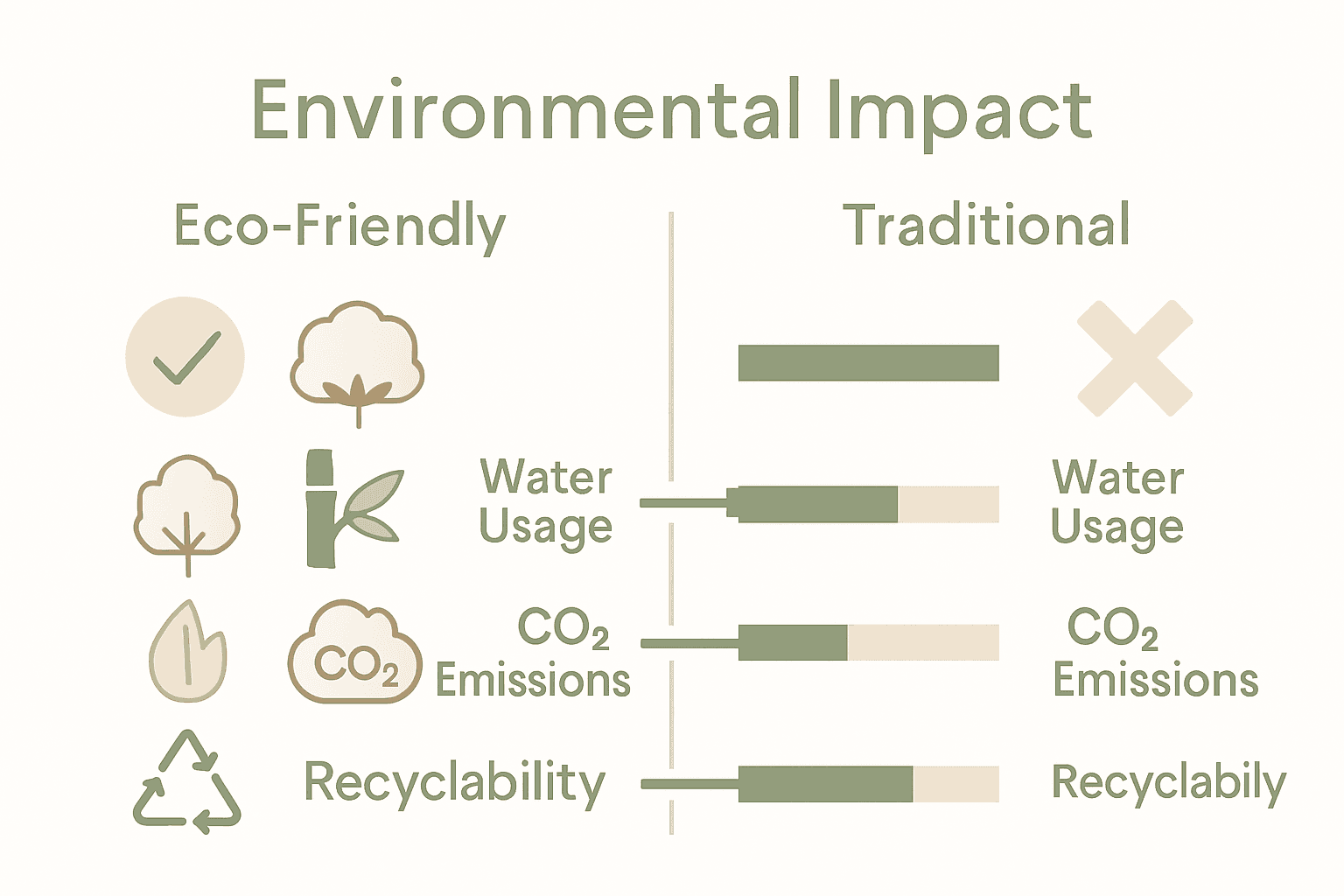Eco Clothing Explained: Sustainable Fashion Essentials
Did you know that the fashion industry is responsible for over 8 percent of global carbon emissions each year? What you wear can have a real impact on the planet. Eco clothing is reshaping fashion with materials and methods that protect both people and nature. Discover how making more conscious wardrobe choices leads to a cleaner world and supports a new standard of style.
Table of Contents
- Defining Eco Clothing and Its Core Principles
- Major Types of Eco-Friendly Clothing Materials
- Sustainable Production Practices in Fashion
- Spotlight on Leading Ethical Fashion Brands
- How to Shop and Care for Eco Clothing
Key Takeaways
| Point | Details |
|---|---|
| Eco Clothing Defined | Eco clothing emphasizes sustainability, ethical production, and minimal environmental impact through organic and eco-friendly materials. |
| Sustainable Materials | Key eco-friendly fabrics like organic cotton, bamboo, hemp, Tencel, and recycled polyester offer diverse benefits and minimize negative impacts. |
| Responsible Production Practices | Sustainable fashion includes water conservation, chemical management, and fair labor practices, transforming production methods within the industry. |
| Shopping Mindfully | When purchasing eco clothing, prioritize quality, versatility, and thorough research on brand sustainability commitments and material sources. |
Defining Eco Clothing and Its Core Principles
When we talk about eco clothing, we’re diving into a world where fashion meets environmental consciousness. Eco clothing represents a transformative approach to fashion that prioritizes sustainability, ethical production, and minimal environmental impact. According to research from Wikipedia, organic clothing specifically is crafted from materials grown in strict compliance with organic agricultural standards, including textiles like cotton, jute, linen, silk, ramie, and wool.
The core principles of eco clothing extend far beyond simply choosing organic materials. These garments are designed with a holistic view of environmental and social responsibility. Key characteristics include:
- Sustainable Sourcing: Using materials that have minimal negative environmental impact
- Ethical Manufacturing: Ensuring fair labor practices and worker welfare
- Low Carbon Footprint: Reducing greenhouse gas emissions during production
- Circular Design: Creating clothing that can be recycled or biodegraded
Interestingly, the innovative world of eco textiles goes beyond traditional organic materials. Wikipedia highlights biotextiles as specialized materials engineered from natural or synthetic fibers that interact uniquely with biological systems. These advanced textiles offer remarkable properties like biocompatibility, enhanced porosity, and superior mechanical strength.
Learn more about making responsible fashion choices in our guide on ethics in fashion. Fashion should feel like freedom — wear what tells your story, consciously and courageously.
Major Types of Eco-Friendly Clothing Materials
Understanding the landscape of eco-friendly clothing materials is key to making sustainable fashion choices. According to TextileSchool, eco-friendly fabrics are revolutionizing the textile industry with innovative materials like recycled polyester (rPET), bamboo linen, and Tencel (Lyocell), each offering unique sustainable alternatives to traditional textiles.
Organic Cotton stands out as a foundational eco-friendly material. Grown without harmful pesticides or synthetic fertilizers, it represents a gentler approach to textile production. Other remarkable sustainable materials include:
- Bamboo Fabric: Rapidly renewable, soft, and naturally antimicrobial
- Hemp: Requires minimal water, grows quickly, and produces strong, durable fibers
- Tencel (Lyocell): Made from wood pulp, biodegradable, and produced through environmentally responsible processes
- Recycled Polyester: Transforms plastic waste into wearable, high-performance clothing
Research from Kawintextile confirms that these eco-friendly materials not only benefit the environment but also offer exceptional skin-friendly properties. By choosing these innovative textiles, you’re supporting a more sustainable and responsible fashion ecosystem.

Here’s a comparison of major eco-friendly clothing materials and their sustainability features:
| Material | Key Sustainability Benefit | Unique Property |
|---|---|---|
| Organic Cotton | Grown without harmful pesticides | Soft and breathable |
| Bamboo Fabric | Rapidly renewable resource | Naturally antimicrobial |
| Hemp | Minimal water use, fast growth | Durable and strong fibers |
| Tencel (Lyocell) | Biodegradable, low-impact process | Made from wood pulp, soft texture |
| Recycled Polyester | Reduces plastic waste | High performance, versatile |
For more insights on building a conscious wardrobe, check out our guide to sustainable summer clothes.
 Fashion is your canvas — paint it green, bold, and beautiful.
Fashion is your canvas — paint it green, bold, and beautiful.
Sustainable Production Practices in Fashion
Sustainable fashion is more than a trend — it’s a comprehensive approach to reimagining how clothing is created. According to TextileSchool, sustainable production practices involve strategic methods that reduce environmental impact through resource efficiency and minimized chemical usage, particularly by incorporating eco-friendly fabrics like recycled polyester and bamboo linen.
The core principles of sustainable production encompass several critical strategies:
- Water Conservation: Reducing water consumption in textile manufacturing
- Chemical Management: Eliminating toxic substances from production processes
- Energy Efficiency: Utilizing renewable energy sources
- Waste Reduction: Implementing circular design principles
- Fair Labor Practices: Ensuring ethical working conditions
Research from Kawintextile highlights how materials like organic cotton and Tencel are produced with minimal environmental footprint while simultaneously promoting worker and consumer health. These innovative approaches transform fashion from a resource-intensive industry to a model of responsible production.
To dive deeper into conscious fashion choices, explore our guide on understanding sustainable fashion. Your wardrobe can be a powerful statement of change — one stitch at a time.
Spotlight on Leading Ethical Fashion Brands
The landscape of ethical fashion is rapidly evolving, with innovative brands pioneering sustainable practices that challenge traditional manufacturing norms. According to TextileSchool, major brands like H&M are incorporating recycled polyester into their collections, strategically working to reduce CO₂ emissions and promote more environmentally conscious fashion choices.
Ethical fashion brands are distinguished by their commitment to multiple sustainability dimensions:
- Transparent Supply Chains: Revealing production processes and worker conditions
- Responsible Material Sourcing: Prioritizing organic, recycled, and low-impact textiles
- Circular Design: Creating clothing with recyclability and longevity in mind
- Minimal Waste Production: Implementing zero-waste manufacturing techniques
- Fair Labor Practices: Ensuring ethical wages and safe working environments
Research from TextileSchool highlights brands like MagicLinen, which emphasize sustainability through long-lasting linen apparel that combines durability with environmental consciousness. These brands aren’t just selling clothing — they’re selling a vision of responsible consumption.
For deeper insights into conscious fashion choices, explore our guide on understanding conscious fashion. Your wardrobe is a statement — make it count.
How to Shop and Care for Eco Clothing
Making mindful choices in your wardrobe begins with strategic shopping and intentional care. According to TextileSchool, when shopping for eco clothing, prioritize garments made from recycled polyester and bamboo linen, which offer substantial sustainability benefits while maintaining style and quality.
When shopping for eco-friendly clothing, consider these essential strategies:
- Research Brand Values: Investigate a company’s sustainability commitments
- Check Material Composition: Look for organic, recycled, and low-impact textiles
- Verify Certifications: Seek out recognized environmental and ethical standards
- Invest in Quality: Choose pieces designed for durability and longevity
- Consider Versatility: Select items that can be styled multiple ways
Research from Kawintextile emphasizes the importance of gentle care for eco-friendly fabrics like organic cotton and Tencel. Preserve your sustainable wardrobe by using mild detergents, washing in cold water, air-drying when possible, and avoiding harsh chemicals that can degrade fabric quality and environmental integrity.
For more insights on clothing maintenance, check out our guide to caring for clothing like a pro. Your wardrobe is a reflection of your values — treat it with love.
Embrace Sustainable Style with Be Juliet
Understanding the importance of eco clothing means you want fashion that respects both the planet and your personal expression. The article highlights the challenge of finding clothing made from sustainable materials like organic cotton, bamboo fabric, and recycled polyester that also fits your lifestyle and values. At Be Juliet, we honor your desire to wear pieces crafted with love and responsibility by offering collections that blend comfort, elegance, and sustainability.
Explore our Women’s Outerwear – Coats, Jackets, Blazers & More for timeless pieces made to elevate your wardrobe while supporting ethical production practices.

Now is the perfect moment to upgrade your closet with thoughtful fashion choices that celebrate your authentic self. Discover the freedom of dressing consciously with our curated styles on Sweaters & Sweatshirts and expert pieces designed for the woman who leads with love. Begin your journey to a wardrobe filled with purpose and passion at Be Juliet. Your sustainable fashion story starts here.
Frequently Asked Questions
What is eco clothing?
Eco clothing represents a sustainable approach to fashion, focusing on environmental consciousness, ethical production, and minimal environmental impact. It includes materials grown organically and emphasizes responsible manufacturing practices.
What materials are commonly used in eco-friendly clothing?
Common eco-friendly materials include organic cotton, bamboo fabric, hemp, Tencel (Lyocell), and recycled polyester, each offering unique sustainability benefits while being gentle on the environment.
How can I ensure the clothing I buy is truly eco-friendly?
To ensure clothing is eco-friendly, research brands’ values, check material composition, verify environmental certifications, invest in quality pieces, and consider versatility for multiple uses.
How should I care for my eco clothing to maintain its quality?
To maintain the quality of eco clothing, use mild detergents, wash in cold water, air-dry when possible, and avoid harsh chemicals that can degrade the fabric and its environmental integrity.
